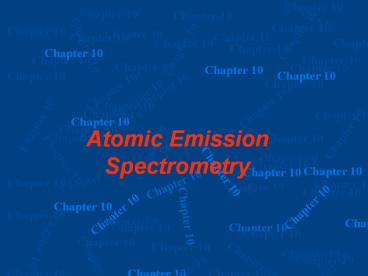Atomic Emission Spectrometry - PowerPoint PPT Presentation
Title: Atomic Emission Spectrometry
1
Chapter 10
Chapter 10
Chapter 10
Chapter 10
Chapter 10
Chapter 10
Chapter 10
Chapter 10
Chapter 10
Chapter 10
Chapter 10
Chapter 10
Chapter 10
Chapter 10
Chapter 10
Chapter 10
Chapter 10
Chapter 10
Chapter 10
Chapter 10
Chapter 10
Chapter 10
Chapter 10
Chapter 10
Chapter 10
Chapter 10
Chapter 10
Chapter 10
Chapter 10
Chapter 10
Chapter 10
Chapter 10
Chapter 10
Chapter 10
Atomic Emission Spectrometry
Chapter 10
Chapter 10
Chapter 10
Chapter 10
Chapter 10
Chapter 10
Chapter 10
Chapter 10
Chapter 10
Chapter 10
Chapter 10
Chapter 10
Chapter 10
Chapter 10
Chapter 10
Chapter 10
Chapter 10
Chapter 10
Chapter 10
Chapter 10
Chapter 10
Chapter 10
Chapter 10
Chapter 10
Chapter 10
Chapter 10
Chapter 10
Chapter 10
Chapter 10
Chapter 10
Chapter 10
Chapter 10
Chapter 10
Chapter 10
Chapter 10
Chapter 10
Chapter 10
Chapter 10
Chapter 10
2
Plasma
Ar
e-
Ar
e-
Plasma is an electrical conducting gaseous
mixture containing a significant concentration of
cations and electrons.
e-
e-
e-
Ar
Ar
Argon ions once formed can absorb energy from
external sources and maintain temperature to
sustain plasma indefinetly.
e-
e-
Ar
- Types of high temperature plasmas
- Inductively coupled plasma
- Direct current plasma
- Microwave induced plasma
Ar
e-
Ar
Ar
3
Inductively Coupled Plasma Torch
Radio frequency induction coil 27-41 MHz 0.5-2KW
Plasma torch F 2.5 cm
Tangential flow isolates the torch from plasma
Plasma argon
Sample argon
Argon flow rate 5-20 L/min
Tangential argon plasma support flow
4
Sample Introduction
Plasma argon
Auxiliary plasma argon
Aerosol carrier Argon
Sample solution
To drain
5
Electrothermal Vaporization
To ICP
Sample
Graphite rod
Heater power
Water coolant
Argon inlet
6
Temperature in a Typical ICP Source
Temperature oK (10)
6000
25
6200
20
Height above load coil mm
6500
15
6800
8000
10000
7
Radial ICP Source
To spectrometer
4 to 10 fold improvement in detection limit
8
Three Electrode DC Plasma Jet
Plasma column
Excitation region
Anode block
Ceramic sleeve
Electrode
Electrode
Anode block
Sample and Argon
9
Desirable Properties of Emission Spectrometers
- High resolution (0.01 nm)
- Rapid signal acquisition and recovery
- Low stray light
- Wide dynamic range
- Accurate and precise wavelength selection
- Precise intensity reading
- High stability with respect to environmental
changes - Easy background correction
- Computerized operation readout, storage, ...
10
Plasma Source Spectrometers
- Simultanuos or multichannel
- Sequential
11
Slew Scan Spectrometer
Exit slit
Composite grating
Mirror
Filter wheel
Photomultiplier tubes
Motorized observation height
Plasma torch
Mirrors
Hg lamp
Entrance slit
12
Diffraction grating
Position feedback
Capacitive transducer
17-Bit DAC
Rotor shaft
5
Servo amp
Eelectromagnetic coil
Magnetically driven grating
13
Echelle Polychromator
Aperature plate
Prism/lens
Echelle grating
Plane mirror
Computer adjustable source mirror
Collimating mirror
Entrance slit
Source
14
Multichannel Spectrometers
- Polychromator
- Array-based systems
15
Measuring electronics
Dedicated computer
Instrument control electronics
Schematic of an ICP polychromator
16
Applications
- Sample preparation
- Elements determined
- Line selection
- Calibration curves
- Interferences
- Detection limits
17
H
He
Li
Be
B
C
N
O
F
Ne
Al
Si
P
S
Cl
Ar
Na
Mg
K
Ca
Sc
Ti
V
Cr
Mn
Fe
Co
Ni
Cu
Zn
Ga
Ge
As
Se
Br
Kr
I
Xe
Rb
Sr
Y
Zr
Nb
Mo
Tc
Ru
Rh
Pd
Ag
Cd
In
Sn
Sb
Te
Ti
Pb
Bi
Po
At
Rn
Cs
Ba
Hf
Ta
W
Re
Os
Ir
Pt
Au
Hg
Fr
Ra
La
Ce
Pr
Nd
Pm
Sm
Eu
Gd
Dy
Ho
Tm
Yb
Lu
Tb
Er
Th
Pa
U
Np
Pu
Am
Cm
Md
No
Lr
Bk
Ac
Cf
Es
Fm
18
Typical Calibration Curves
Tl 334.94 nm
10
Photocurrent ( na)
1
V 437.92 nm
Nb 371.30 nm
Ce 456.24 nm
0.001
0.0001
0.1
0.01
Impurity concentration in iron ( wt)
19
Calibration Curve
Ba
Deionized water
Cr
5000 mg/mL Na
Cd
Tap water (500 ppm hardness)
Zn
Pb
200 mg/mL Ca, 200 mg/mL Mg ( all solutions 0.1 M
HCl)
Intensity ratio
0.03
0.1
0.3
1.0
3.0
10
Concentration mg/mL
20
(No Transcript)
21
(No Transcript)
22
Suggestions Appreciated! Chemistry
Depatement, Shiraz University,
IRAN nzmaleki_at_gmail.com Sites.google.com/site/simi
nstrumentslab

